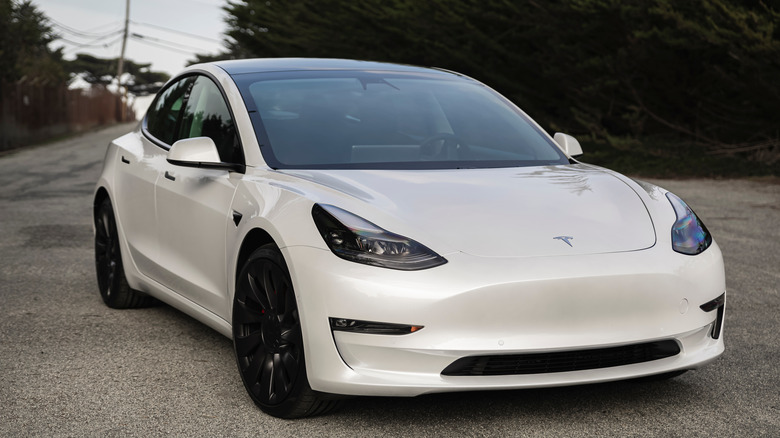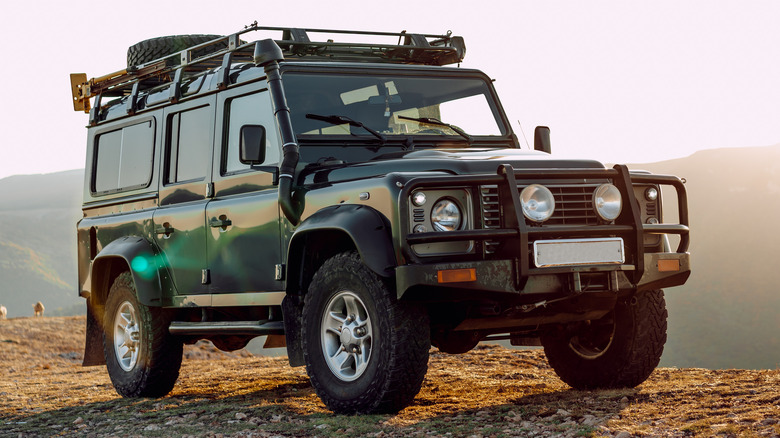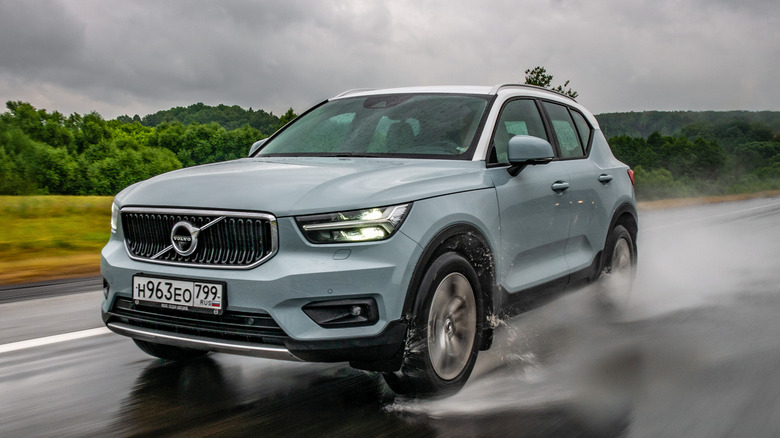What's The Difference Between 4WD And AWD?
When it comes to buying a car, be it new or used, there are many characteristics and features that must be considered. Do you want a manual transmission or would you rather the more common automatic? What engine size do you need? Do you want a two-door or a four-door vehicle? And among all of these questions, of course, is a big one: should you get a two-wheel drive, four-wheel drive (4WD), or all-wheel drive (AWD) vehicle?
If you've ever shopped for a new car, you've likely seen distinctions between 4WD and AWD. Most people have a general idea of what they mean — 4WD means the power is delivered to all four wheels, but shouldn't AWD be the same? As it turns out, they're similar but there are a few important characteristics that make 4WD and AWD quite different. Put simply, one of these two options works best for off-roading activities while the other is intended for general driving, particularly if that driving takes place in the snow or heavy rain.
What is all-wheel drive?
So, what is AWD on a car? All-wheel drive is intended for use on asphalt — yes, it will work on other surfaces, too, but it's mostly made for general driving. Put simply, an all-wheel-drive car has to ability to send power to all four wheels at once. This generally makes a car more powerful than its two-wheel-drive counterparts. It should be noted that an AWD car does this all the time whereas a 4WD option would only do it when needed. You should also know that with an all-wheel-drive car, the wheels can go at different speeds during turns, according to Car and Driver.
AWD can be found in just about any car category, but you mostly see it on high-performance cars, modern SUVs, and passenger cars the most. This is because AWD cars can be driven in just about any weather condition and these types of cars are usually the everyday commuters needed to take kids to school or to run general errands. One way to look at AWD cars is that they are very general and can be applied to most situations, and they may prove particularly useful when it's raining or snowing outside.
What is four-wheel drive?
Whereas AWD can be used constantly (though many cars switch to 2WD at times to help save on gas), this is not the case for 4WD cars. For the most part, these types of cars are reserved for off-road use or perhaps on slippery surfaces (via Popular Mechanics). Of course, you can also use a 4WD on normal roads, but it would mostly be wasted on asphalt and it really shines in off-road situations such as climbing hills. With this option, the driver must manually enter 4WD mode to use it; this is usually done by turning a knob to enable the mode.
When this happens, the front and rear driveshafts are locked together. This forces the axles on both the front and the rear to turn at the same speed. Four-wheel drive vehicles are beneficial because this ensures torque is always being delivered to at least one wheel, which is why 4WD vehicles are ideal for off-roading. Typically speaking, you'll find a 4WD option on certain types of vehicles, including rugged Jeeps, trucks, and most other models designed for off-road use.
4WD and AWD downsides
Although both all-wheel drive and four-wheel drive have their advantages, they are not for everyone and can make some aspects of owning a car more expensive. The biggest drawback most people think of concerning both types of vehicles is fuel economy. The fact is that both 4WD and AWD cars will cost you more at the pump. The technology needed to make all four wheels work means more fuel will be used per mile. In addition, there is often a size difference between the cars that use all four wheels and your 2WD options, which also impacts fuel usage.
Other than fuel economy, many people who buy either 4WD or AWD cars feel that they have to give up something to have another. If you get an AWD car, it feels like you can't use it for off-road activities, although you can, just only to an extent. If you get a 4WD car, then you're only really getting the capabilities some of the time, which some off-roading fans don't appreciate.
AWD vs 4WD in snow and ice
Weather conditions are another lens through which to compare AWD and 4WD vehicles. While both options provide improved traction for harsh weather, they are also different in this category. According to Car and Driver, general snowy or icy weather is best combated by an all-wheel-drive system. This goes back to AWD cars being user-friendly because these systems are automatic. In other words, the driver simply has to drive on the snowy or icy road and the AWD system will apply as much traction, or torque, as needed.
However, if you live in a place that regularly experiences particularly harsh weather where the snow piles up, you may want to consider 4WD. For example, if there's a good chance your winter driving will involve having to climb icy hills or power through deep piles of snow, it'd probably be better to go with the 4WD option. Once again, both 4WD and AWD bring a great deal to the table, but even when it comes to weather conditions, it simply depends on the needs of the buyer.
4WD vs AWD: Which is better?
We know that both all-wheel drive and four-wheel drive cars have their place in the car world because each option provides a way to deliver power to all four tires; it's how this is accomplished that makes them different. Which one a buyer chooses is typically — if they did their research — a direct reflection of the type of driving they'll be doing most. But, is one overall better than the other? For most people who use their vehicles for general purposes, all-wheel drive will be the better option. One of the biggest reasons is that AWD cars have a less complex mechanical setup than 4WD options. This means that an all-wheel-drive car will be much more economically friendly in terms of maintenance repair costs (via True Car).
Another reason the average driver would consider AWD the better is that it's user-friendly. This is because the system is always on and requires no extra attention to detail on the part of the driver. Overall, unless you plan to hit the trails and truly use your vehicle as an off-road ride through rocky and treacherous terrain, you don't really need 4WD when AWD basically does the same thing, but with fewer drawbacks.





